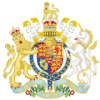Roman Catholic Relief Act
 Roman Catholic Relief Act received the Royal Assent on 13 April 1829 (sometimes called the Catholic Emancipation Act). Image: the Royal coat of arms of the United Kingdom of Great Britain and Northern Ireland.
Roman Catholic Relief Act received the Royal Assent on 13 April 1829 (sometimes called the Catholic Emancipation Act). Image: the Royal coat of arms of the United Kingdom of Great Britain and Northern Ireland.
The Catholic Relief Act of 1829 allowed Catholics to become Members of Parliament and to hold public offices, but it also raised the property qualifications that allowed individuals in Ireland to vote. The passage of the Catholic Relief Act marked a shift in English political power from the House of Lords to the House of Commons. The Act was led by the Duke of Wellington and passed despite initially serious opposition from both the House of Lords and King George IV.
Articles
Related Articles
Carolyn Vellenga Berman, “On the Reform Act of 1832″
Sean Grass, “On the Death of the Duke of Wellington, 14 September 1852″
